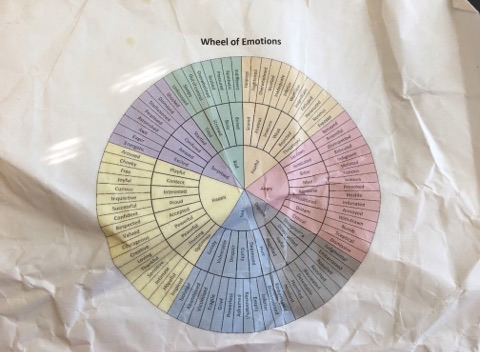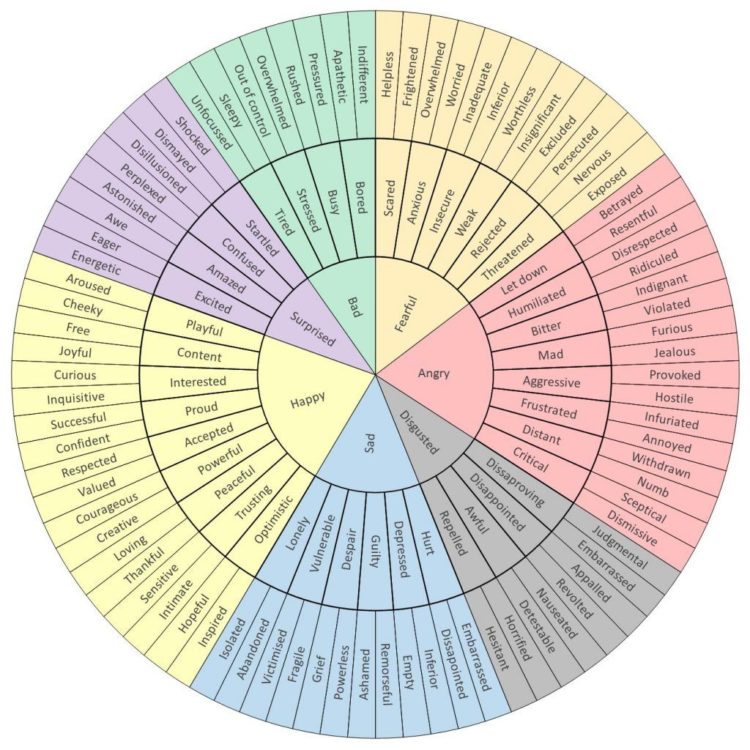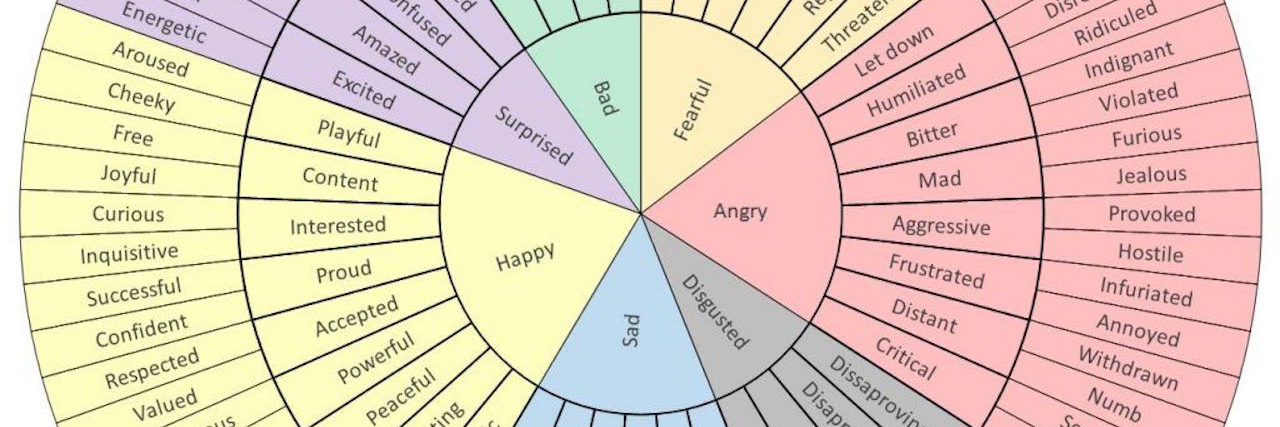The 'Emotion Chart' My Therapist Gave Me That I Didn't Know I Needed
Editor's Note
If you experience suicidal thoughts, the following post could be potentially triggering. You can contact the Crisis Text Line by texting “START” to 741741.
I’ve always described myself as an “after-reactor,” meaning I don’t typically react to things as they’re happening. I intellectually process what’s happening, whether it be bad news, an overwhelming task or a hard situation, but can often have a hard time feeling it.
I can’t lie, this has served me well. I can be pretty great at handling stress, compartmentalizing and temporarily putting away feelings I’ve deemed unhelpful. It’s easy for me to “leave things at the door” when I go to work, because you can’t be distracted by things you’re not processing, right? This is how I learned to function in high school. This is how I juggled so much in college. This is largely still how I function now. Avoid bad feelings. Suppress and move on. Emotions can’t hurt you when you don’t feel them…
It doesn’t take a psychologist to guess where this is going.
Because of course, feelings you don’t feel don’t simply go away. They don’t seep into the ground never to return again. In fact, it’s more like the water cycle. Whatever the earth absorbs eventually comes back as rain. Except in this version of the water cycle, the more water that goes unused and unprocessed, the bigger the storm. Water you ignore comes back with fury, demanding your attention, raining big, angry drops on your head.
For me, this rain can manifest physically through stomachaches and back pain no amount of stretching relieves. It comes out in bad thoughts, like, “I want to kill myself,” a sentence that sometimes (although, thankfully, not recently) runs through my mind, a placeholder for whatever negative emotions I didn’t process that day.
Then, it comes out in bursts of emotion, triggered by seemingly “little” things. A change in dinner plans leaves me sobbing on my bed. One off-hand comment from a friend (combined with too many drinks), and I’m fighting self-harm urges in a public bathroom. Something happens in a TV show, and I cry as if it’s happening to me, suddenly unable to breathe by a fictional plot that is vaguely related to something personal.
But yet, as things are actually happening, it’s still hard for me to feel. It’s as if my brain is trying to protect itself, working in overdrive so I can still function. It makes it hard for me to identify how I really feel about things. It makes it hard for me to process emotions in real time.
During a fight with my boyfriend, he begged me to tell him how I was feeling.
“Nothing,” I responded. And I meant it. “I feel nothing.”
Later, while we were in the car, I screamed.
I talk about this in therapy, but only after my wonderful therapist called me out. Even in her office, I tend to recount stories as if they didn’t happen to me, intellectually analyzing events and avoiding discussions about how things actually made me feel.
My therapist isn’t big on worksheets or homework, so I was surprised when after one session, she excused herself to get something for me. What she handed me was a piece of paper I didn’t know I needed: a Wheel of Emotions. It’s a simple chart, with different levels of color-coded emotions, meant to help those who possess it identify how they’re feeling. I stared at it, and was hooked.

Maybe it’s because I’m a writer, or maybe it’s because the colors are nice, but I’ve found this to be one of the more helpful tools I’ve been given for my mental health. For me, what makes the Wheel of Emotions so great is that it starts out relatively vague, and then moves on to more specific, intense emotions. Now when I, for example, reference this tool when talking to my boyfriend (yes, this has happened), I start by looking at the emotions in the middle. Even if I think I feel nothing about what we’re talking about, I can usually at least choose an emotion to start. My options are: Bad, Fearful, Angry, Disgusted, Sad, Happy, Surprised.
If I can’t pinpoint exactly how I’m feeling, but know, at the very least, I feel “bad,” I can then move on to the next layer. (Do I feel Bored, Busy, Stressed or Tired?) Then, I can even go one step deeper. If I feel Stressed, do I also feel Overwhelmed or Out of Control? Do I feel both? Even if there isn’t one “perfect” label to sum up how I’m feeling, it sets me in the right direction. It gives me some language to talk about how I feel. It’s better than “nothing.”
According to American psychologist Dr. Robert Plutchik, humans can experience 34,000 distinguishable emotions. He developed a wheel of emotions that looks a little different than mine, which you can find here. As stated in the resource about navigating Plutchik’s Wheel of Emotions, the “deeper” you get on the wheel, the more intense the emotional response. No matter what your Wheel of Emotions looks like, the concept is still the same — humans are capable of so many vast and complicated emotions. Identifying them is a practice. Dealing with them can be a strength. I included a bigger (and hopefully easier to read) version of my Wheel of Emotions below so you can take a look:

Even before I was given my new favorite piece of paper, slowly but surely I’ve been getting better at feeling my feels. Anger has gotten a little easier to process. I’m trying to take away shame from feelings I think are “illogical” or “wrong.” I’m trying to own myself as an emotional person, and remind myself that while burying “bad” emotions is tempting, and even “helps me” in the short-term, it always bites me in the end. It inhibits my growth, rather than helping it, and just because I can push through bad feelings doesn’t mean I have to.
The magic thing about processing and identifying emotions while they’re happening is that afterwards, I often feel lighter. I can deal with what I’m going through without giving the storm festering inside of me more fuel. Identifying my emotions, with the aid of my dear wheel, has been a big help on my own mental health journey. If you’re someone who struggles with identifying emotions, I hope it’s a tool that can help you too.
Lead image via www.classtools.net

